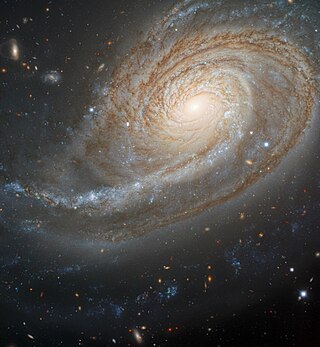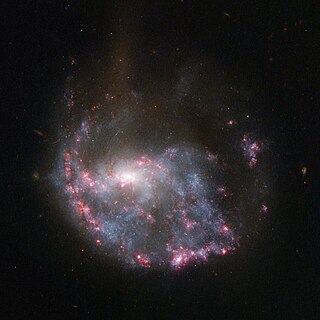
NGC 3982(also known as UGC 6918) is an intermediate spiral galaxy approximately 68 million light-years away in the constellation Ursa Major. It was discovered by William Herschel on April 14, 1789, and misclassified as a planetary nebula. NGC 3982 is a part of the M109 Group.

NGC 1097 is a barred spiral galaxy about 45 million light years away in the constellation Fornax. It was discovered by William Herschel on 9 October 1790. It is a severely interacting galaxy with obvious tidal debris and distortions caused by interaction with the companion galaxy NGC 1097A.

NGC 772 is a large unbarred spiral galaxy approximately 106 million light-years away in the constellation Aries. It was discovered on 29 November 1785 by German-British astronomer William Herschel.

NGC 5921 is a barred spiral galaxy located approximately 65 million light-years from the Solar System in the constellation Serpens Caput. It was discovered by William Herschel on 1 May 1786. In February 2001 a type II supernova was discovered in NGC 5921. It is a member of the Virgo III Groups, a series of galaxies and galaxy clusters strung out to the east of the Virgo Supercluster of galaxies.

NGC 1032 is a spiral galaxy that is about 117 million light-years away in the constellation Cetus. It was discovered on 18 December 1783 by German-British astronomer William Herschel.

NGC 4639 is a barred spiral galaxy located in the equatorial constellation of Virgo. It was discovered by German-born astronomer William Herschel on 12 April 1784. John L. E. Dreyer described it as "pretty bright, small, extended, mottled but not resolved, 12th magnitude star 1 arcmin to southeast". This is a relatively nearby galaxy, lying approximately 72 million light-years away from the Milky Way. It is a companion to NGC 4654, and the two appear to have interacted roughly 500 million years ago. NGC 4639 is a member of the Virgo Cluster.

NGC 5907 is a spiral galaxy located approximately 50 million light years from Earth. William Herschel discovered the galaxy in 1788.

NGC 3738 is a dwarf galaxy in the constellation of Ursa Major and belongs to the M81 Group of galaxies. NGC 3738 is 12 million light-years from the Sun. The galaxy was first discovered by astronomer William Herschel in 1789. NGC 3738 is a blue compact dwarf, which is small compared to large spiral galaxies. The galaxy is about 10,000 light-years across. It is one-tenth the size of the Milky Way.

NGC 922 is a peculiar galaxy in the southern constellation of Fornax. Its velocity with respect to the cosmic microwave background is 2879 ± 15 km/s, which corresponds to a Hubble distance of 138.5 ± 9.7 Mly (42.46 ± 2.98 Mpc). Additionally, 17 non-redshift measurements give a distance of 138.88 ± 7.47 Mly (42.582 ± 2.291 Mpc). It was discovered by German-British astronomer William Herschel on 17 November 1784.

NGC 4206 is a spiral galaxy located about 70 million light-years away from Earth in the constellation of Virgo. The galaxy is visible with most moderate amateur telescopes at 13th magnitude. It was discovered by British astronomer William Herschel on 17 April 1784 and is a member of the Virgo Cluster.

NGC 3198, also known as Herschel 146 is a barred spiral galaxy in the constellation Ursa Major. It was discovered by William Herschel on 15 January 1788. NGC 3198 is located in the Leo Spur, which is part of the Virgo Supercluster, and is approximately 47 million light years away.

NGC 428 is a barred spiral galaxy in the constellation of Cetus, with its spiral structure distorted and warped, possibly the result of the collision of two galaxies. There appears to be a substantial amount of star formation occurring within NGC 428 and it lacks well defined arms — a telltale sign of a galaxy merger. In 2015 the Hubble Space Telescope made a close-up shot of the galaxy with its Advanced Camera for Surveys and its Wide Field and Planetary Camera 2. The structure of NGC 428 has been compared to NGC 5645.

NGC 676 is a lenticular Seyfert 2 galaxy in the constellation Pisces. Its velocity with respect to the cosmic microwave background is 1217 ± 20 km/s, which corresponds to a Hubble distance of 58.6 ± 4.2 Mly (17.96 ± 1.29 Mpc). In addition, two non redshift measurements give a distance of 61.0 ± 2.6 Mly (18.7 ± 0.8 Mpc). The galaxy was discovered by German-British astronomer William Herschel on 30 September 1786.

NGC 7457 is an unbarred lenticular galaxy in the constellation Pegasus. NGC 7457 is its New General Catalogue designation. It was discovered by the astronomer William Herschel on 12 September 1784.

NGC 5486 is an irregular galaxy in the constellation Ursa Major 110 million light-years from Earth.

NGC 7329 is a large barred spiral galaxy located in the constellation Tucana. NGC 7329 was discovered by British astronomer John Herschel in 1835.

NGC 5777 is a large edge-on spiral galaxy located in the constellation Draco. Its speed relative to the cosmic microwave background is 2,210 ± 5 km/s, which corresponds to a Hubble distance of 32.6 ± 2.3 Mpc. NGC 5777 was discovered by German-British astronomer William Herschel in 1789.

NGC 2283 is a barred spiral galaxy in the constellation of Canis Major. Its velocity with respect to the cosmic microwave background is 994 ± 11 km/s, which corresponds to a Hubble distance of 14.66 ± 1.04 Mpc. It was discovered by German-British astronomer William Herschel on 6 February 1785.

NGC 1162 is a lenticular galaxy located in the constellation Perseus. It was discovered by astronomer William Herschel on October 14, 1784. The galaxy lies approximately 200 million light-years away from Earth and is classified as a type SA0^−^ galaxy, indicating a smooth structure with little to no spiral features.

NGC 1164 is a barred spiral galaxy located in the constellation Eridanus, approximately 60 million light-years from Earth. It was discovered by the astronomer John Herschel in 1834. NGC 1164 is classified as a (R')SAB(rs)b type spiral galaxy, with a prominent central bar structure and well-defined spiral arms.




















